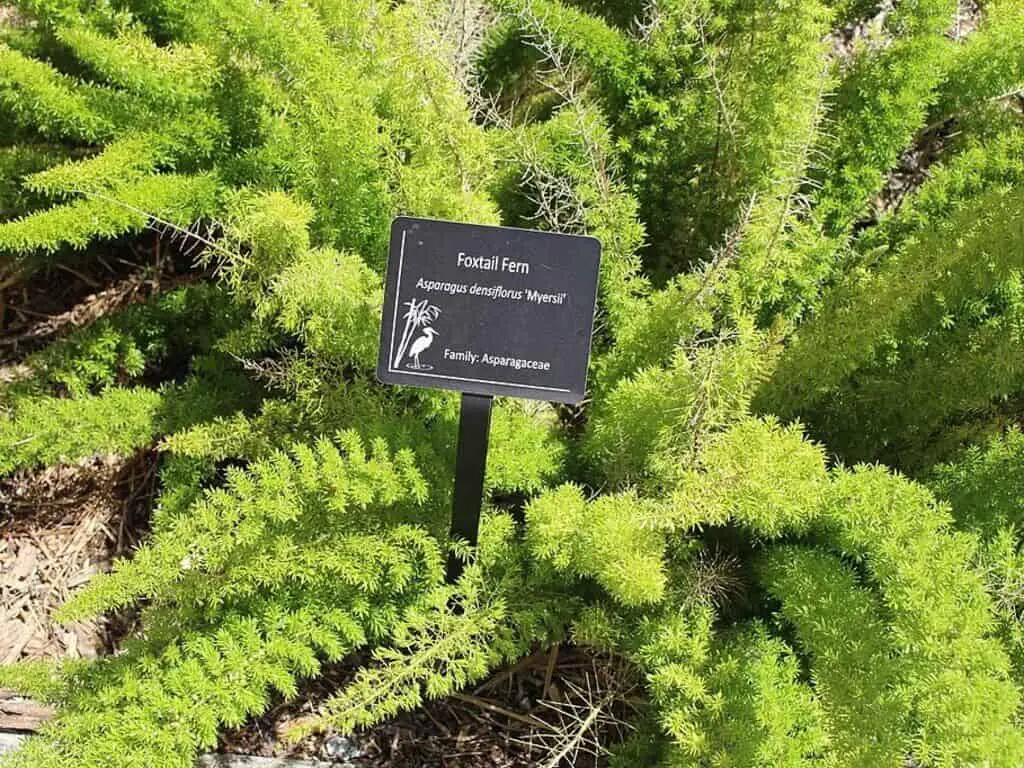How to Grow and Care for Foxtail Fern Plants
In fact, the foxtail fern is not a real fern. It is a member of the asparagus family of plants. It reproduces by seeds and not sexually from spores as ferns do. Previously, it was assigned to the lily family. But later, it was reclassified to the present asparagus family.
In this article, we have briefed foxtail fern plants, their characteristics, propagation, and uses.
In general, foxtails plants are low-maintenance plants. They can bring life to your indoor spaces and also decorate your outdoor landscapes. Since they have a long lifespan (about 3 weeks!), they are popular in floral arrangements.
Table of Contents
Characteristics of Foxtail Fern Plants

Photo by Michael Rivera (Wikimedia Commons) (CC BY-SA 4.0)
These plants are also known as asparagus ferns or Myers ferns. The fronds of these plants resemble the tails of the foxes. Typically, they are lush, long, and soft. They are also called stems or spears. From the ground, they raise and twist, appearing in a cylindrical shape.
Typically, the tuberous taproots grow extensively underground. They provide water and essential nutrients as required by the plant. Hence, this plant does not require much caring as most other plants do.
The strong taproots of these plants also store water to some extent. Therefore, these plants can tolerate occasional droughts. Moreover, these strong roots can ‘conquer’ the weak roots of other plants in their vicinity.
The shape of the evergreen leaves resembles that of soft pine needles. In the spring, these plants sprout tiny white flowers. These flowers attract bees and butterflies. During the fall, these flowers turn into inedible red berries.
In general, these perennials grow around 2-3 feet tall and the same as wide. In USDA Zones 9-11, these plants can thrive outdoors throughout the year. If you live in cooler zones, shift them indoors during winters. Typically, these plants are not too picky about climatic conditions, except for cool weather.
Types of Foxtail Fern Plants
Asparagus Densiflorus
When it comes to foxtail fern plants, Asparagus densiflorus comes to the minds of most people. In other words, Asparagus densiflorus is most commonly termed as foxtail fern.
Also known as Myers fern, this variety has thick stems that grow upright. This variety has many cultivars. Among them, ‘Myersii’ or ‘Myers’ is the most popular and bestselling cultivar.
Asparagus Aethiopicus
This variety has different names including Sprenger’s asparagus and asparagus grass. However, these species are also called foxtail fern and asparagus fern. As a result, most people confuse between Asparagus Aethiopicus and Asparagus Densiflorus.
Even though both of them belong to the same family, they are different species. In fact, the stems of this variety droop downwards as they grow. Hence, it can suit well for hanging gardens or hanging baskets.
Like its cousin species, this variety also produces white flowers and inedible red berries. It can also be a good choice for layered beds, where you can interplant different foxtail fern cultivars and other like plants.
Propagation of Foxtail Fern Plants
Sunlight
Foxtail fern plants thrive well under full sun. However, they require partial shades, especially during the hot afternoons. Similarly, while growing indoors, they need bright, indirect light. Otherwise, they may turn yellow.
You can also make use of grow lights if your indoors are deprived of natural light.
Temperature
Ideally, these plants thrive well in temperatures about 65 – 70° F. They can also tolerate a little bit of cold. However, temperatures below 25° F can damage or kill these plants.
Water & Humidity
Water these plants deeply about once a week. Typically, this encourages the tubular roots to grow deeper in the soil, chasing the water downwards. Allow the soil to dry about three inches in between watering.
Also, make sure not to overwater, making the soil soggy. This may invite various diseases to the plants.
While growing indoors, mist them occasionally with water. You can also place them on a tray containing water. This increases the humidity. These plants prefer to grow in high humid conditions.
Soil
In general, these plants are not picky about the soils. They can grow well in many types of soils that have good drainage. Typically, these types of plants do well in slightly acidic soils.
Fertilizer
Before planting, it is recommended to amend the soil with organic matter or compost. It provides the plants with essential nutrients and helps them to grow healthier.
Division Propagation
Typically, most gardeners use division to propagate Asparagus ferns. This is one of the best, easiest and fastest methods to grow these plants.
1.) Select an established healthy plant, free from diseases and pests.
2.) Uproot the entire plant from the ground surface. Then, dust it off for loose soils and other debris.
3.) Using a sharp garden knife or pruning saw, divide the roots into 2 pieces or more. Make sure each segment has root parts and greenery.
4.) You can plant each individual segment in a separate pot and also on the ground surface at different locations.
Water the planted segments thoroughly during the initial stages. Typically, the new plants take a few years to establish themselves.
Seed Propagation
Start the seed propagation indoors, 4 – 6 weeks prior to the last frost date in your area. You can purchase the seeds online or at any garden center nearby.
You can also collect the seeds yourself if you already have these plants in your garden. Just collect the ripen berries from the plant and remove the seeds. Then, rinse the seeds thoroughly in water for cleansing the pulp and other debris away.
Dry the seeds for a few hours. Then, using sandpapers, rub them to remove the hard outer coating a little bit. This makes them permeable. After that, soak them in lukewarm water overnight.
1.) Fill a seed-raising tray with a good quality seed-starting mix up to 0.75 inches from the top. Then, tap it down firmer.
2.) Spread the seeds 1 inch apart on the surface of the starting mix. Then, spread a thin layer of seed starting mix again on the seeds gently to cover them.
3.) Using a spray bottle, mist the top surface of the soil. After that, wrap the tray with a plastic cover. This helps to maintain consistent humidity levels.
4.) For faster germination, maintain the temperature at about 70° F. You can also use heat mats for this purpose.
You can expect the germination to complete in about a month. During this time, maintain the soil moist by misting it occasionally as needed.
After germination, remove the plastic wrap and place the tray in a sunny spot like a window sill. This helps the seedlings to grow healthier and faster. When they develop at least 2 – 3 sets of true leaves, you can transplant them in your gardens or pots.
Caring for Foxtail Fern Plants
Fertilizer
In general, it is necessary to fertilize the plants during the growing season. It replenishes the plants with fresh energy and also supplies essential nutrients. As a result, the plants thrive healthier and produce better yields.
Apply slow-release, balanced fertilizers to the plant soil in spring, summer, and also in the fall. Alternatively, you can apply liquid fertilizers (half strength) once a month during the entire growing season.
Like most plants, Asparagus ferns go dormant after the growing season in the winters. Hence, avoid overwatering and over-fertilizing, especially during the winters.
Pruning
In general, the foxtail fern plants grow quickly. Hence, to curb its aggressive growth, you may have to prune them regularly. It also helps to maintain the bushy appearance of these plants.
If do not care about the above factors, you can just prune them occasionally, to prevent spaces restrictions. However, it is recommended to cut off the infected and dead portions regularly. This helps to ensure the good health of the plants. Most commonly, pruning is done in spring.
Repotting
If you grow foxtail fern plants in pots, they may need to be repotted every year. Typically, the fleshy, thick tubular roots of these plants tend to outgrow the pot in less than a year.
In general, spring is the best season for fresh activities including repotting. Select a pot that is only 2 inches larger compared to the previous pot. This helps to curb the aggressive growth of the asparagus ferns.
Similarly, for new plants, the distance between the root ball and the pot rim should be about an inch.
Other Factors
If the plants drop leaves or decolorize, they may be deprived of water. It can also be due to stress from too much lighting. Hence, changing the locations or adjusting the watering frequencies can solve the problem.
Pests and Diseases
In general, the foxtail fern plants are not frequently infected by pests and diseases. However, you may have to watch them, especially in unfavorable environments.
Pests
Upon pest infections, most commonly, these plants exhibit discoloration or droopiness signs. Hence, you can easily identify the trouble. Some common pests that infect Asparagus ferns are as follows:
Fern Mites
Due to the tiny sizes of fern mites, identifying them is a challenging task. Often, the damage is visible after it grows to serious levels. Typically, it causes deformation or stunt-growth in foliage. Also, the leaves lose their color and turn yellow.
Nematodes
Nematodes are a type of small worm. They cause wilting, stunt growth, or discoloring in foliage. They can also infect the tubular roots beneath the ground surface.
Mealy Bugs
Mealybugs are a type of common scale insect. Usually, they are white in color and have many short legs. They suck the sap liquids out of plants, which can cause the plants to die. In most cases, the signs of infestation are droopiness and discoloration.
Treatment
If the infection is minimal, you can use a cotton swab, immersed in rubbing alcohol to remove them.
Neem oil is a proven organic pest control. You can treat almost all common pests with neem oil sprays.
Diseases
Fungal Root Rot
Like succulents, Asparagus ferns store water in their roots to thriving in droughts. So, overwatering may lead to fungal root rots easily in them. Hence, water only when the top 2-3 inches of soil becomes dry.
Typically, the infection signs include yellow leaves, wilting and stunted growth. If you suspect the disease, remove the plant entirely. Inspect the roots for infection. Cut off the decayed/infected portions.
You can also relocate the plant to a different spot. Before that, enrich the soil with essential nutrients. Allow the ground to dry about 2 -3 inches before watering.
Leaf Blight
Leaf blight is a fungal disease. It begins on foliage as small reddish-brown spots. Usually, yellow halos surround these spots. In fact, this disease is related to iron deficiency.
Typically, the symptoms include decolorization of foliage and necrotic death at leaf tips. You can treat this infection with common fungicides. If the infection persists, prune the infected potion entirely.
For preventing these types of diseases, feed the plants with iron-based (slow-release) fertilizers twice a year.
Uses of Foxtail Fern Plants
You can use grow foxtail fern plants in wild gardens, hanging gardens (Asparagus aethiopicus), and also in rain gardens. They provide unique beautiful looks wherever they grow.
They fit perfectly for perennial borders along with flowering or ornamental plants. You can also grow them simply in pots for beautifying patios and lawns. They serve well as indoor plants too, particularly in winters.
If you live in USDA Zones 9 – 11, you can utilize them as seaside plants. They can tolerate salt to some extent. They can also be used in cut flower arrangements as greenery additions. After separating from bases, the beautiful fronds can thrive for up to three weeks. Then, they turn yellow and die in a few days.
Frequently Asked Questions
Drifts
Top 10 Best Brush Cutter Machines USA 2021 and Buyer’s Guide
Top 10 Best Pre-Emergent Herbicide Solutions USA 2021 and Buyers Guide





